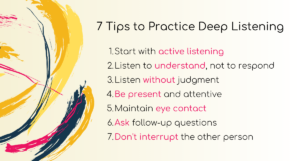
From Deaf Ears to Attentive Mind: My Challenging Journey to the Art of Listening
From Deaf Ears to Attentive Mind: My Challenging Journey to the Art of Listening https://tcpgrowth.com/wp-content/uploads/2023/09/1-1024x550.png 1024 550 Margot Margot https://secure.gravatar.com/avatar/3d371c596b95c891d90a47035ce643cd?s=96&d=mm&r=g- Margot
- no comments
I’ll admit it—I’m an activator. Always on the go, moving at lightning speed, eager to make things happen. Tick tock, tick tock, my heart starts racing when I have to wait for the speaker to get to the meat of their point. Do you share a similar feeling?
But in my relentless pursuit of results, I overlooked a crucial skill: deep listening.
Active listening, empathetic listening, generative listening – these concepts were completely foreign to me until I stumbled upon the world of coaching five years ago. It slapped me in the face that I had been fooling myself into thinking I was a good listener when in reality, I was partially “deaf” and had a lot to learn.
It took me months, actually years, to truly practice and embrace this skill. I finally realized that while I may excel in presentation or strategic communication, deep listening was the missing link that could take my connections to a whole new level – creating not just business relationships, but genuine, lasting human connections that go beyond the surface.

Research emphasizes active listening’s crucial role in business negotiation.
The Harvard Negotiation Project confirms its significance, stating, “Active listening leads to satisfying agreements for both parties.” Active listening improves agreement rates, builds relationships, gathers information, solves problems effectively, reduces miscommunication and conflicts, and enhances client satisfaction.
Embracing active listening empowers negotiators to achieve mutually beneficial outcomes, fostering trust and cooperation.
Thus, no excuse but to keep practicing deep listening!
What exactly is deep listening?
In the fast-paced realm of business, it’s easy to rely on our experience and quick thinking, reacting, and strategizing based on our own agendas. But deep listening goes beyond that. It’s about creating a safe space where others feel truly heard, understood, and valued.
It means setting aside our judgments, resisting the urge to interrupt, and fully immersing ourselves in the speaker’s world.
Deep listening enables us to form genuine connections and gain profound insights that transcend transactional interactions. It holds the power to transform our relationships and enhance the way we engage with others.
Here is a useful list to help us practice deep listening in the workplace, suggested by Pumble:
- Tip #1: Start with active listening
- Tip #2: Listen to understand, not to respond
- Tip #3: Listen without judgment
- Tip #4: Be present and attentive
- Tip #5 Maintain eye contact
- Tip #6: Ask follow-up questions
- Tip #7: Don’t interrupt the other person
I simply stick a posit in front of my desktop to remind myself of these “golden rules”.

Apparently, these are some of the tips on how to practice deep listening. However, my personal journey has taught me that it all boils down to a deeper level of awareness. It’s about listening with my heart, organizing the thoughts with my mind, and decoding the essence of the message with my soul.
Deep listening goes beyond the mechanics; it requires a genuine connection on a profound level.
When I approach conversations with this mindset, I find that the barriers dissolve, and a harmonious exchange takes place. It’s in this space of heartfelt understanding that true transformation occurs, both for myself and those I connect with. Let’s all actively engage in deep listening to catalyze meaningful human connections.
I am still practicing. And you?

- Posted In:
- Margot Ling

